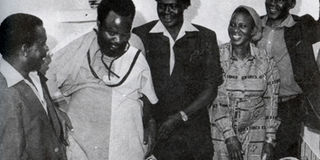How Milton Obote returned from exile

Obote in Bushenyi at his return from exile. Second Left is Edward Rurangaranga while extreme right is Adonia Tiberondwa and his wife Mary.
What you need to know:
Hero in waiting? May 27 marked 33 year since the historic return of former Uganda President Dr Apollo Milton Obote from Tanzania exile after nine years. Faustine Mugabe looks back at the emotions, divisions and opportunities that would stem from his return.
Kampala
This week, May 27, marked 33 year since the historic return of the former Uganda President Dr Apollo Milton Obote from exile after nine years in Tanzania. So historic that his return ideologically divided the nation into two spheres and changed the political bearings of the country.
The nation was divided between the Uganda Peoples Congress (UPC) adherents who welcomed their hero back from exile and those who had tagged him a brute leader who should never have returned to haunt Uganda.
For the latter group rooted, especially in Buganda and in collaboration with the Democratic Party (DP) and its sympathisers across the country, the return of Obote was catastrophic to the nation in their eyes. The Buganda public opinion thought that without Obote on Uganda’s political scene, the re-birth of the Buganda Kingdom was inevitable while the DP leadership was guaranteed of the occupying the State House.
However, there was the third party though small; the Front for National Salvation (Fronasa) led by the little known Yoweri Museveni then. Fronasa was somewhat sympathetic to Buganda and DP and detested UPC venomously.
Unstoppable
Every attempt was made to deny Obote a second entry into Uganda’s politics. The architects of the famous Moshi Conference held in Tanzania ensured that Dr Obote as an individual was locked out of the meeting. But they failed in blocking his return to Uganda. Obote had his ‘Listening Posts’ within the conference and therefore was well apprised about the deliberations.
But Obote being the ‘Master of Politics’ as was popularly known, especially by his adherents, formulated a counter plan that his opponents and enemies could not block. From Tanzania, Obote and his spin doctors, draft a proposal which was debated by the ‘parliament of Uganda’.
The National Consultative Council (NCC), on June 19, 1979 passed resolution which stated that Uganda shall establish a new tradition and political culture where citizens would treat their leaders whether in power or not with reverence and in a civilised conduct.
It further stated that all former Presidents and leaders must not leave in exile outside Uganda.
The NCC thus directed the National Executive Committee (NEC) of the Uganda National Liberation Front (UNLF) to accord a VIP treatment, including security and other amenities to Mr Obote upon his return since he fell in the category of the former leaders of the Uganda. This also gave Mr Obote an opportunity to enjoy many privileges unlike three other presidential candidates during the 1980 campaigns.
The passing of the resolution by the NCC meant that the political arena in Uganda had tilted against Obote’s opponents. Now that it was obvious that the president of the party would return undeterred, UPC adherents across the country started to organise for the former president’s home-coming. A national ad-hoc committee was established to plan for his welcome.
Chaired by Dr Luwuriza Kirunda, the committee had 13 other members who included Dr David Anyoti Obiara, Ben Wacha, Obua Otoa, Dr Albert Picho Owiny, Stephen Omoding Ariko, Sam Tewungwa, Dr Adonia Tiberondwa, and Masette Kuuya. Others were: Chris Rwakasisi, Anthony Butele, James Rwanyarare, Edward Rurangaranga, Tem Lalobo and Osindek Wangor.
On Ugandan soil
On May 27, 1980, Obote accompanied by his wife Miria Obote and their children, Ms Bananuka among others flew from Tanzania in a military plane and landed at Nyakisharara airfield in Mbarara District.
Obote dressed in a UPC black, red and blue short-sleeved shirt was visibly emotional. Upon disembarking from the plane, he first pecked and hugged John Babiha, his former vice-president before he greeted other dignitaries present. The Nation, Standard newspapers of May 29, 1980 as well as the Drum magazine of June 1980 reported the event.
After taking refreshments, Obote’s convoy headed for Ishaka township where as the chief guest, he was welcomed by an estimated 15,000 people. To his cheering audience, in a live broadcast by Radio Uganda, he said: “Let it be known that Uganda’s decade of shame is at last over.
Let it be known that the decade of misrule, lawlessness and corruption during which one of the beautiful and richly endowed countries in Africa was exploited and plundered beyond imagination and reduced to virtual wasteland is over”.
At the rally, Dr Obote also promised that the UPC government, if voted into power had a marshal economic reconstruction and recovery programme for Uganda which he said that within three years, the fruits of that national project would be visible to the world. However, many of such projects were hampered by the Luwero war.
For instance, in 1983, the University of Bushenyi (UoB) project died when the rebels of the National Resistance Army (NRA) intensified the war by opening the western Axis. The University of Bushenyi had been planned to be operational by the end of 1985.




